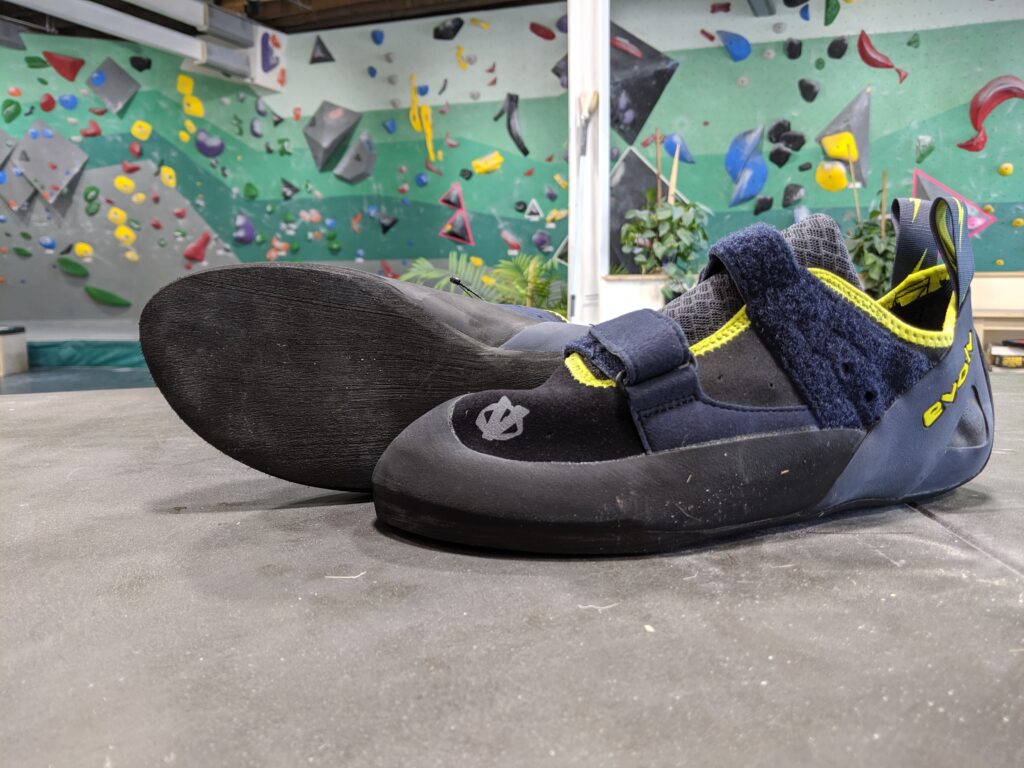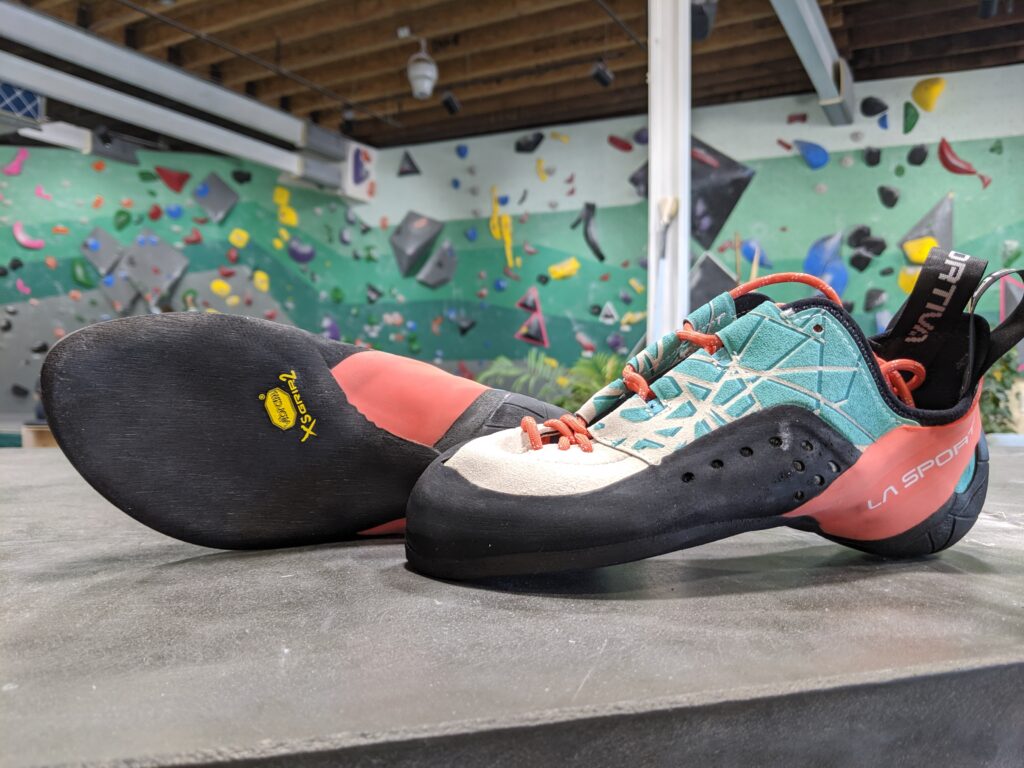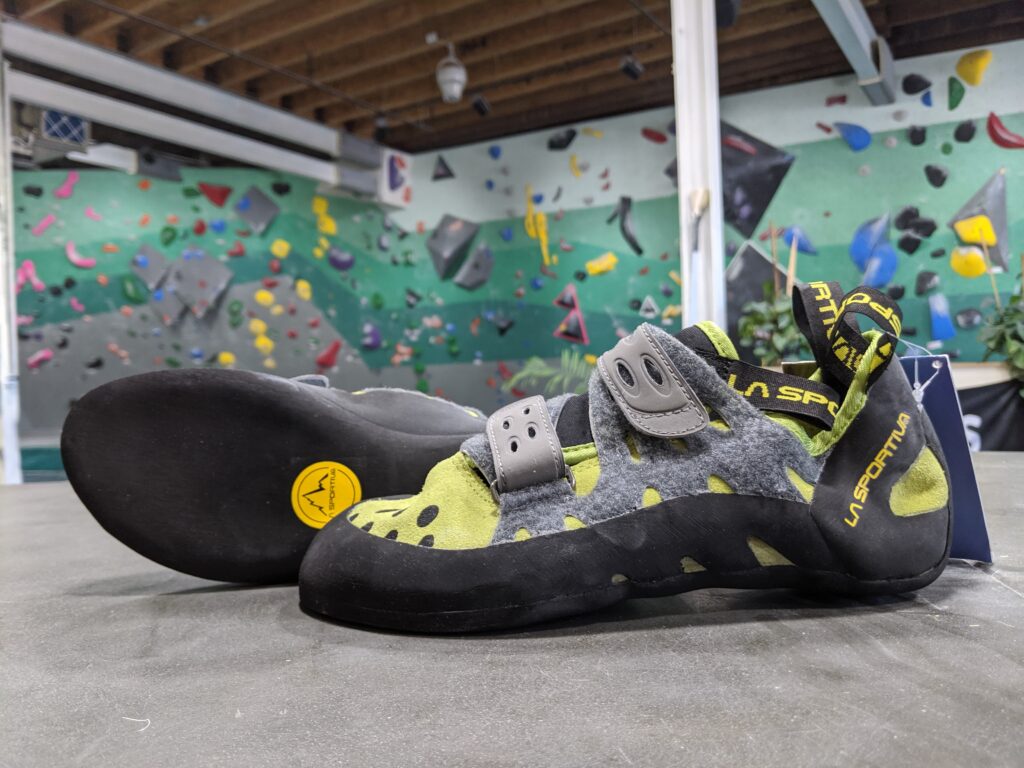Whether you find yourself on bouldering pads or tied-in to a top-rope climb, buying your first pair of climbing shoes and buying your tenth pair of climbing shoes can be a remarkably similar experience. When buying a climbing shoe there are a number of key factors to look out for. Since climbing has a number of different disciplines – bouldering, sport climbing, and traditional climbing – there has been a breadth of diverse climbing shoes to address the individual challenges of each discipline. However, there are universal aspects of shoe shopping, climbing or otherwise, that we should cover first. In this blog we will go over why we wear climbing shoes, the materials that make up a climbing shoe, and how to find the right shoe for the right climb.
Why Wear Climbing Shoes?
Much like a bowling alley, your favorite climbing gym has rental shoes. Ever wonder why? In bowling, having a dedicated bowling shoe not only keeps the approach (what bowlers call the area leading to the foul line) free of outside mud and debris but also allows for the bowler to adjust the friction between the shoe and the approach, as well as get a more tailored and secured fit. For climbers, a dedicated climbing shoe keeps routes and pads free of outside grime and has a sticky rubber sole to – you guessed it – provide necessary friction between the shoes and the climb. Nowadays climbing shoes are designed with the climber in mind: many shoes concentrate the weight of the climber on the big toe for the smallest of foot jibs or have extra-thin rubber to give climbers a sensitive feel of the wall.
How Should A Shoe Fit?
Each climber is unique – each climbing shoe is unique. Fret not! Here are some quick and dirty tips for fitting climbing shoes without having to try every single pair:
- Make sure your toes are touching the front of the climbing shoe! Climbing is all about using your legs (read all about it here) to stand up to holds instead of pulling up to them. A well-fitting shoe will provide a stable foundation for your footwork.
- Get ‘em Snug! Climbing shoes should be snug but not too tight – kind of like a pair of ballet slippers, or a soccer cleat.
- Account for stretch! Depending on the material that your climbing shoes are made from they might stretch a up to a full size! Other materials might not stretch one bit – but these are typically synthetic uppers, which means they are less breathable.
A Note About Sizing
Since the dawn of climbing, folks have yearned to assign an abstract number to just about anything – like climbing grades. Climbing shoes did not escape this desire. Much like climbing grades, shoe sizing can seem quite arbitrary. Some companies, like La Sportiva, anticipate folks sizing down one and half to two full sizes in their climbing shoes. Others make their shoes true-to-size out of the box. This is not including other changes that might take place – such as changing from a US “women’s” street-shoe size to the European equivalent to the climbing shoe equivalent.
To make matters more complicated, one company can use several different models for the shape of the foot and lead to inconsistencies with sizing across models of the same brand, not to mention the variation across brands. In short, try climbing shoes out in person if possible. There is no accounting for personal preference! Also, keep in mind that all shoes stretch over time – but some stretch more than others. Check out the Symmetry, Volume, and Material paragraph for more information.
What Kind of Climbing Are You Into?
Bouldering, sport climbing or top-roping, trad climbing – slab, vertical, overhung.
The kind of shoe you pick depends on the kind of climbing you’re interested in, as well as the type of terrain you want to tackle. For example, if you are about to embark on a 50-foot top-rope, you might want a shoe you can wear all day with minimum adjustment – whereas if you’re about to embark on a day of bouldering then taking your shoes off
Just because a shoe is intended for one style of climbing it does mean that it can’t perform well in others. There are trade-offs. Tufas is a bouldering-only facility but we have a diverse range of shoes from the most aggressive on the market to the best-selling all-day comfort climbing shoes. It’s important to try as many shoes as possible in person in order to assure the right fit.
However, climbing is still a relatively marginal sport and there are a limited number of companies and shoe models out there – so there is no guarantee of the perfect shoe. Experienced climbers will often have several pairs of shoes acquired over time, typically for a variety of terrain. Multi-pitch climbers have been known to bring a pair of very aggressive shoes for the crux pitches and a more moderate pair for the rest of the climb in order to avoid fatiguing their feet.

Finding Your Perfect Shape
A last is the wood, metal, or plastic model of a foot used by climbing shoemakers. Lasts dictate factors that affect the fit of a climbing shoe, as well as the kind of performance they would be best suited for. Remember: lasts vary depending on the model of the shoe, and from company to company. There is no substitute for trying shoes out in person to assure an accurate fit!
Volume – The interior space of a shoe is called the volume. Traditionally, gendered terms were used to incorrectly describe low-volume shoes as women’s and high-volume shoes as men’s. It is important for climbers to try on a variety of shoes for that perfect fit – so keep an eye out for a high and a low volume version of a shoe!
Aggression – Aggression is the term used to describe how downturned the toes of a climbing shoe are. Ranging from neutral to moderate to aggressive, downturned shoes allow climbers to concentrate their power on their toes during steep climbs or boulders. Beware: more aggressive shoes tend to hurt your feet quicker than more moderate shoes. This might not be a problem for a bouldering session as you can take shoes off between attempts but is certainly not advisable for anyone planning on some all-day climbing.
Symmetry – If aggression refers to how cambered or downturned a climbing shoe is, then symmetry-asymmetry refers to how curved a shoe is from the heel-to-toe. An asymmetrical shoe is really curved to the big toe, letting the weight further concentrate on the big toe. High asymmetry combined with a really aggressive shoe gives us a tight, performance-oriented bouldering shoe. However, not all asymmetrical shoes are aggressive and vice versa. It’s important to note that although the term has fallen out of favor, it is still included in a lot of climbing shoe descriptions.
Closure Types
There are trade-offs. Sometimes, your perfect shoe might be a mismatch for your favorite style of climbing. In my case, it fits one foot but not the other, or is no longer being made. This is not to be confused with your favorite shoe! The Five Ten Moccasyms that I got in at Everfree are two sizes too big and absolutely atrocious for overhanging boulders (mmm, my favorite!), but I wear them any chance I get, like warm-ups on big holds, when crack climbing, or with wool socks in the wintertime.
There are a variety of closure types for climbing shoes. Some offer more control over fit – others allow for a quick on-off. Here are the main three examples:
Laces – You can’t beat a classic. Climbing shoes have been using laces since the early days. Back then there were no climbing shoe brands or companies, just stiff mountaineering boots Laced enclosures allow for the most precise fit. The climber is able to adjust for pressure points, loosen for a more relaxed fit, or tighten the laces when it’s time to perform. Laces are a good all-rounder dating back to the OG climbing clogs. Precise lacing is, however, time-consuming.
Velcro enclosures are easy to put on and take off and provide a nice middle ground between laces and slippers. Velcro is more secure than a slipper and not as time-consuming as lacing. Some climbing shoemakers opt for two or three Velcro enclosures to optimize fit without compromising speed. This makes them great for bouldering!
Slippers are considered the most comfortable enclosure when it comes to climbing shoes. While they are considerably less secure than laces or Velcro – slip on climbing shoes remain a popular option for crack climbing and a speedy on-off option. It is not uncommon for the slip-on climbing shoe enclosure to be supported by a set of Velcro straps (ya know – just in case).

Other Features
Climbing shoes also come in a variety of materials. Depending on the kind of uppers your climbing shoes use in addition to their super sticky climbing shoe rubber, your shoes may stretch up to a full size up from what’s on the label!
Lined Leather – Expect your lined leather climbing shoes to stretch up to half a size. While not as breathable as unlined leather, they’re still less likely to stink up your gym bag like a synthetic climbing shoe.
Unlined Leather – Beware! Unlined leather climbing shoes will stretch up to a full size as they mold to your foot. They are, however, supremely breathable and the least stinky material available.
Synthetic – No room for stretching here! Synthetic materials sacrifice breathability for a total lack of stretch. With synthetic climbing shoes, what you see is what you get!
How to Get the Most Out of Your Climbing Shoes
Climbing shoes are expensive – so it’s important to get the most out of each pair. One shoe saving strategy is to keep a pair for indoor climbing, and a separate pair for your outdoor climbing ventures. Keep in mind that climbing gyms with their textured walls and volumes can eat through your shoes a lot quicker than the occasional trip to the crag.
Another way to save some green is to practice precise footwork. It doesn’t matter if you’re bouldering, sport climbing, or even climbing on ice – footwork is essential to climbing. If you’re lazy with your feet then watch as layer after layer of rubber is stripped away with constant adjustments, smears due to poor aim for the foothold, and the dreaded foot drag as you try to feel your way up the wall instead of confidently stepping up.
Something else to keep in mind – climbing shoes can be resoled. You spent close to two hundred dollars and six months breaking your dream shoes – besides, why sully the environment by buying a whole new pair? Artisans across the U. S. offer climbing shoe resole so you don’t have to suffer through another break-in period. On the other hand, if your shoes are old, loose, and hazardously stinky – then maybe resoling isn’t the best option for you.
In Short…
| Sizing | Climbing shoes should be snug but not too tight – soccer cleats.
|
Most brands will sell a high-volume and low-volume version of the same shoe – sizing varies! | Be flexible! Sizes are unique to brands – and no two feet are alike! Try as many shoes as possible
|
| Shape
|
Aggressive, Moderate, or Neutral: how downturned a shoe dictates how effective it is on the overhang. | Aggressive shoes are perfect for boulderers who can take them off between tries but might be way too painful for day-long multi-pitch route, or long stretches at the gym | Slab, Vert, Overhang:
A full, stiff midsole thrives on slab. A more flexible midsole, or a total lack of one, might be the better option for steep overhangs. |
| Features | Slippers for easy on/off.
Velcro for easy on/off and security. Laces for max security. |
Unlined leather – full size stretch
Lined leather – half size
Synthetic – no stretch
|
Downturn: how much weight the shape of the shoe puts on the big toe.
|
| Tips | Toes touching the front of the shoe – no deadspace! No room to wiggle!
|
Try them without socks for a closer fit! It doesn’t hurt to have a few diverse pairs for diverse styles of climbing. | Make sure your heel fits comfortably – no pinching the Achilles tendon! |
Z. Kudratov wrote this, among other things. They’re an imported Philadelphian with a soft spot for public transportation, public radio, and the PMA.
